Home | Category: Gods and Mythology / People, Marriage and Society
AMAZONS
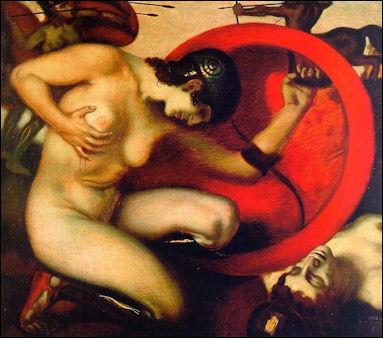
Wounded Amazon
The Amazons were a band of fearless warriors described as "maidens fearless in battle" and "women the peers of men." They were lead by a queen who wore a belt to symbolize her power and lived on the north side of Black Sea. No men were allowed to live in their kingdom. The Amazons consorted with men only once a year during a festival. Afterwards the men that were used were turned into eunuchs, enslaved or killed. Only female offspring were kept, boys were disposed of.
The Amazons fought with spears, shields, bows and arrows. They supposedly cut off one of their breasts so they could carry a shield. The word Amazon is sometimes erroneously said to have been derived from the Greek for "without one breast." It more likely means "those who are not breast-fed."
Owen Jarus wrote in Live Science, “Although details about them vary, the Amazons were depicted as beautiful and bloodthirsty women, with strong matriarchal ties. They heralded from what is now modern day Turkey. When called upon, the men played their part in reproduction, or they served as slaves. Male babies were often killed or sent back to their fathers, and girls were raised by their mothers to tend to crops, hunt and become the warriors they were famed for being.” [Source: Owen Jarus, Live Science, October 12, 2015]
The Amazons reportedly engaged in battles in Egypt, Libya, Syria and Arabia. They fought on the side of the Trojans in the Trojan War. One of the labors of Hercules was to steal the girdle of an Amazon Queen. According to Greek myth, the Amazons were defeated in the Battle of Thermodon on the southern coast of the Black Sea and taken prisoners by the Greeks. The Amazons managed to overpowered the Greeks on their boats while they were heading home when a storm cast them on land in Scythian territory, where they later paired up and produced children with the Scythians.
Websites on Ancient Greece: Internet Ancient History Sourcebook: Greece sourcebooks.fordham.edu ; Hellenistic World sourcebooks.fordham.edu ; BBC Ancient Greeks bbc.co.uk/history/; Perseus Project - Tufts University; perseus.tufts.edu ; ; Gutenberg.org gutenberg.org; British Museum ancientgreece.co.uk; Illustrated Greek History, Dr. Janice Siegel, Hampden–Sydney College hsc.edu/drjclassics ; Cambridge Classics External Gateway to Humanities Resources web.archive.org/web; Ancient Greek Sites on the Web from Medea showgate.com/medea ; Greek History Course from Reed web.archive.org; Classics FAQ MIT classics.mit.edu
RECOMMENDED BOOKS:
The Amazons: Lives and Legends of Warrior Women across the Ancient World”
by Adrienne Mayor (2016) Amazon.com;
“Searching for the Amazons: The Real Warrior Women of the Ancient World”
by John Man (2018) Amazon.com;
“The Encyclopedia of Amazons: Women Warriors from Antiquity to the Modern Era”
by Jessica Amanda Salmonson (1992) Amazon.com;
“Pandora's Jar: Women in the Greek Myths” by Natalie Haynes (2020) Amazon.com;
“Divine Might: Goddesses in Greek Myth” by Natalie Haynes (2023) Amazon.com;
“D'Aulaires' Book of Greek Myths” by Ingri and Edgar Parin d'Aulaire (1962) Amazon.com;
“The Complete World of Greek Mythology” by Richard Buxton (2004) Amazon.com;
“The Greek Myths” by Robert Graves (1955) Amazon.com;
“Mythology: Timeless Tales of Gods and Heroes” by Edith Hamilton (1942) Amazon.com;
“Mythos: The Greek Myths Reimagined” by Stephen Fry (2017) Amazon.com;
“Heroes” by Stephen Fry (2019) Amazon.com;
Who Where the Amazons
Candida Moss wrote in the Daily Beast, The origins of the term Amazon are rather convoluted and the actual mythology of the Amazons is pretty incoherent and difficult to follow. According to ancient myth Heracles and Achilles both bested Amazon queens in battle. Ancient historians refer to the military skirmishes between the Amazons and lauded ancient leaders like Cyrus the Great of Persia, Alexander the Great, and the Roman general Pompey. Some say that the word “Amazon” comes from the fact that the Amazon women only had one (the left) breast. The famed ancient doctor Hippocrates even describes the medical procedure by which the Amazons achieved this look. He writes that “while they are yet babies their mothers make red-hot a bronze instrument constructed for this very purpose and apply it to the right breast and cauterize it, so that its growth is arrested, and all its strength and bulk are diverted to the right shoulder and right arm.” [Source: Candida Moss, Daily Beast, January 5, 2020]
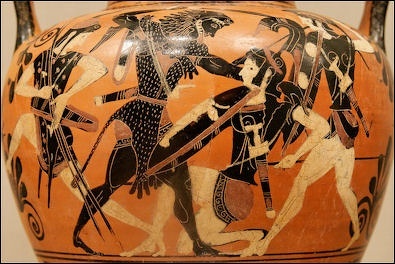
Hercules fighting the Amazons
Ancient sources locate the home of the Amazons in Scythia (or sometimes Asia Minor or Crete) on the fringes of the great ancient empires of Persia, Greece, and Rome. In her thorough book The Amazons classicist Adrienne Mayor argues that historically “Amazons” were not men-free cultures. Within broader ancient Greek and Roman literature, she argues, people used the term “Amazon” as an ethnonym that referred to groups in which women were strong, independent, and equal to men. Amazons weren’t tribes of women, but rather warrior groups from the steppes in which men and women rode into battle alongside one another.
Her argument makes some sense when you look at the literary evidence. The ancient geographer Strabo, for example, discusses the Amazons as a people that was made up or men and women. Others ancient authors refer to them as ruled by women, but none of the ancient sources suggest that they were men-free. In fact, most sources assume that the amazon women were heterosexual. Mayor argues that the ancient Greek argument that the word ‘amazon’ means “with one breast” is a misunderstanding that comes from the practice of strapping the breasts down in order to prevent them from moving while riding. In other words, it’s about their ancient sports bras. Mayor suggests that the actual origins of the word might more probably come from the Iranian ha-mazon, which means warriors.
Some have criticized Mayor’s study for overstating the available evidence and for seeing Amazons everywhere. The red caps sometimes used to identify Amazons in ancient art were also used to portray mythological characters from the eastern Mediterranean. Sometimes a cigar is just a cigar and sometimes a Scythian woman is just a Scythian woman.
Scythian Women Warriors and the Amazon Myth
Descriptions of races of female warriors have been identified in North Africa, the Caucasus, Asia Minor and the steppes of southern Russia. Some scholars believe that Scythians are the source of the Amazon myth and that the Amazons were a real-life tribe of large women warriors that existed in Asia Minor. Supporting this claim are reports from many different sources with the same information — the queens names, their battle tactics and style of dress — and the discovery of a number of burial chambers in the steppes of Russia, the Ukraine and Central Asia women warriors decked out in gold and jewels and outfit with a variety of weapons.
Herodotus relayed stories he heard of Scythian female warriors in the Black Sea that fought side by side with the men in battle and reportedly were not allowed to become warriors until they killed an enemy man. He also said that in some cases these women removed one of their breasts to make shooting a bow easier. One Russian archeologist told National Geographic, "The Greek writers don't mention women warriors among the Scythians. They had to be armed to defend the place where they lived while the men were away."

North of the Black Sea was the home of the Scythians and, purportedly, the Amazons too
Two groups of women warrior that Herodotus called Amazons and the Scythians called Oirpata ("killers of men") ultimately went off together and formed their own tribe. These women were enthusiastic about making love but they didn’t want to be domesticated. One reportedly said: “We are riders, our business is with the bow and the spear...ut in your country....women stay at home in their wagons occupied with feminine tasks, and never go out to hunt, or for any other purpose.”
The grave of one steppe nomad woman thought to be a woman warrior was discovered in 1969 in a kurgan burial chamber excavated near Alma Alta, Kazakhstan. Buried in a 5th century B.C. and initially identified as the Issayk Old Man, the woman was dressed in a boots, trousers, an elaborate 25-inch-tall golden headdress and leather a tunic decorated with some 2,400 arrow-shaped gold plaques as well as dear heads, moose and snow leopards made from gold.
Herodotus on the Amazons
On Herodotus’s story of the Amazons, Joshua Rothman wrote in The New Yorker: “Many thousands of years ago, a group of Greek raiders ventured into what is now northern Turkey. Travelling across the steppe, they came across a group of warrior women. The Greeks kidnapped them, locked them in the holds of their ships, and set sail for home. But the Amazons escaped. They recovered their weapons and killed their captors. Because they were horsewomen, and didn’t know how to sail, the ships drifted far off course. Eventually, though, they landed in the Crimea. The Amazons went ashore and stole some horses. They started marauding, gathering loot, and building up their strength.” [Source: Joshua Rothman, The New Yorker, October 17, 2014]
Herodotus wrote in “Histories” Book 4, 110.1-117.1: “About the Sauromatae, the story is as follows. When the Greeks were at war with the Amazons (whom the Scythians call Oiorpata, a name signifying in our tongue killers of men, for in Scythian a man is “oior” and to kill is “pata”), the story runs that after their victory on the Thermodon they sailed away carrying in three ships as many Amazons as they had been able to take alive; and out at sea the Amazons attacked the crews and killed them. But they knew nothing about ships, or how to use rudder or sail or oar; and with the men dead, they were at the mercy of waves and winds, until they came to the Cliffs by the Maeetian lake; this place is in the country of the free Scythians. The Amazons landed there, and set out on their journey to the inhabited country, and seizing the first troop of horses they met, they mounted them and raided the Scythian lands. [Source: Herodotus, “Histories” translated by A. D. Godley. Cambridge. Harvard University Press. 1920]
“ The Scythians could not understand the business; for they did not recognize the women's speech or their dress or their nation, but wondered where they had come from, and imagined them to be men all of the same age; and they met the Amazons in battle. The result of the fight was that the Scythians got possession of the dead, and so came to learn that their foes were women. Therefore, after deliberation they resolved by no means to slay them as before, but to send their youngest men to them, of a number corresponding (as they guessed) to the number of the women. They directed these youths to camp near the Amazons and to imitate all that they did; if the women pursued them, not to fight, but to flee; and when the pursuit stopped, to return and camp near them. This was the plan of the Scythians, for they desired that children be born of the women. The young men who were sent did as they were directed.
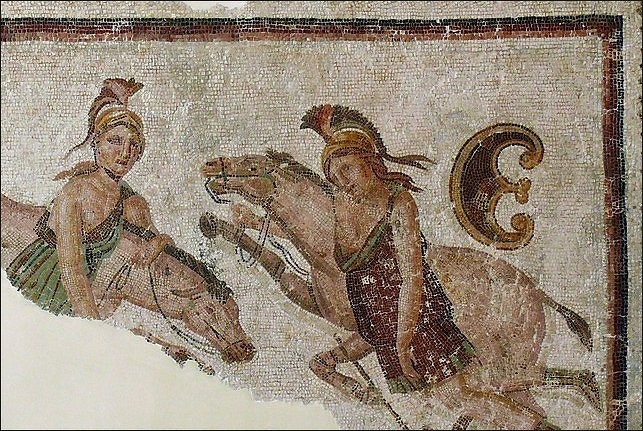
Amazons in a mosaic
“When the Amazons perceived that the youths meant them no harm, they let them be; but every day the two camps drew nearer to each other. Now the young men, like the Amazons, had nothing but their arms and their horses, and lived as did the women, by hunting and plunder. At midday the Amazons would scatter and go apart from each other singly or in pairs, roaming apart for greater comfort. The Scythians noticed this and did likewise; and as the women wandered alone, a young man laid hold of one of them, and the woman did not resist but let him do his will; and since they did not understand each other's speech and she could not speak to him, she signed with her hand that he should come the next day to the same place and bring another youth with him (showing by signs that there should be two), and she would bring another woman with her.
Life of the Amazons
Joshua Rothman wrote in The New Yorker: It’s now possible to know, in a concrete way, what Amazon life was like. The Amazons were likely Scythian nomads who travelled the territory north of the Black Sea—roughly between the Balkans, to the west, and the Caucasus, to the east. They were not, as Mayor puts it, “man-hating virgins,” but simply members of “a people notorious for strong, free women.” (No one knows where the word “Amazon” comes from—it isn’t Greek—but there are a few possibilities, including an ancient Iranian word that means “warrior.”) The Greek way of war centered on infantry—that is, on armored, brawny men. But, on the steppe, “the horse was the great equalizer, along with the bow and arrow, which meant that a woman could be just as fast, just as deadly, as a man,” Mayor writes. [Source: Joshua Rothman, The New Yorker, October 17, 2014 ]
“Amazons spent days at a time on horseback; often, their legs were bowed from so much riding. Their lives followed a yearly cycle, with occasional large gatherings for feasting, funerals, athletic contests, and “purifying saunas.” The Greeks credited the Amazons with inventing trousers, and the Amazons wore them with long-sleeved tunics and pointed hats with ear-flaps. (It was cold out on the steppe.) They drank fermented mare’s milk—you freeze it, then skim off the ice to increase the alcohol concentration. They smoked cannabis, which is indigenous to Central Asia. They were elaborately tattooed.
“They fought on foot, when they had to. (One study of Amazon skeletons with head wounds from battle-axes, Mayor reports, showed that “most of the blows were dealt by a right-handed opponent in face-to-face combat.”) There was fierce competition for territory and resources. Amazons domesticated dogs and hunted with eagles. It’s hard to know much about their spiritual lives, Mayor writes, but archaeological evidence and folktales can give us “an impressionistic sense of the beliefs of the women archers of Scythian lands known as Amazons, an intangible mosaic of animism, totemism, magic, of sacred fire and gold, of reverence for Sun, Moon, sky, earth, nature, wild animals, fantastic creatures. And horses.”“
Sex Life of the Amazons
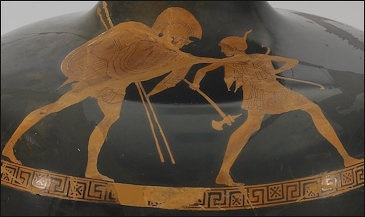
Theseus and an Amazon
Joshua Rothman wrote in The New Yorker: The Greeks, of course, were fascinated by the Amazons’ sex lives. They came up with all sorts of lurid ideas—that they were single-breasted lesbians who killed their male children, or that they mated once a year with strangers to perpetuate an all-female society, or that an Amazon had to kill a man before she could lose her virginity. [Source: Joshua Rothman, The New Yorker, October 17, 2014 ]
“ The idea was that the Amazons had, in some sense, renounced their femininity. The reality of Amazon family life was different. There seems to have been great diversity in approaches to child rearing: archaeologists have found childrens’ skeletons interred with lone men, lone women, and couples. Some groups may have practiced “fosterage”: the exchange of children to cement alliances. The best accounts of “Amazon sex,” meanwhile, suggests that it “was robust, promiscuous. It took place outdoors, outside of marriage, in the summer season, with any man an Amazon cared to mate with.” (Among some groups, “the sign for sex in progress was a quiver hung outside a woman’s wagon.”)
“You can get a sense of the roundedness of the Amazon life by looking at Amazon names. Mayor worked with a linguist and vase expert to examine some of the words on vases depicting Amazons. Previously, they had been considered “nonsense words,” but they turned out to be “suitable names for male and female Scythian warriors in their own languages, translated for the first time after more than twenty-five hundred years.” These ancient Circassian names include Pkpupes, “worthy of armor”; Kepes, “hot flanks/eager sex”; Barkida, “princess”; and Khasa, “one who heads a council.”“
Candida Moss wrote in the Daily Beast: Myth or not, Ancient Greeks and Romans were clearly fascinated by this kind of social organization but never tried to implement these kinds of sex relations themselves. They did, however, share stories about the Amazons and, as Michele Kennerly and Carly Woods have pointed out, make dolls of Amazon women. They even used the image of the Amazon mid-battle preparing to lasso someone to decorate women’s belongings. One fifth century B.C. ‘handbag’ or pyxis, which would have been used to hold jewelry or make up, shows just such a scene. It’s appearance on the bag was a clever joke about the various ways that women ensnare men and, one might say, a form of ancient cultural appropriation. [Source: Candida Moss, Daily Beast, January 5, 2020]
Herodotus on Coupling Between Scythian Youth and on the Amazons
Joshua Rothman wrote in The New Yorker: “Nearby, there happened to be a settlement of Scythians. Most Scythians were nomadic, horse-riding people of the steppe. But these were Royal Scythians—wealthy traders who had settled in towns. To avoid being raided, the Royal Scythians sent out scouts, who discovered that the strange marauders were Amazons. The Scythians found this intriguing. They had planned to send soldiers to kill the marauders; instead, they assembled a party of nice young men. Life in town was luxurious, but it lacked a certain something: the Royal Scythian women mostly stayed indoors, doing chores and feeling bored. Maybe a few fearless, untamed Amazons could spice things up. The band of bachelors travelled out onto the steppe and found the horsewomen. They set up camp and hung around until, one afternoon, one of them encountered a single Amazon, walking alone. “Wordlessly he made advances and she responded,” Adrienne Mayor writes, in “The Amazons: Lives and Legends of Warrior Women Across the Ancient World.” “They made love in the grass. Afterward, the Amazon gestured to indicate that he should return the next day to the same spot—and to bring a friend. She made it clear that she would bring a friend too.” [Source: Joshua Rothman, The New Yorker, October 17, 2014 ]
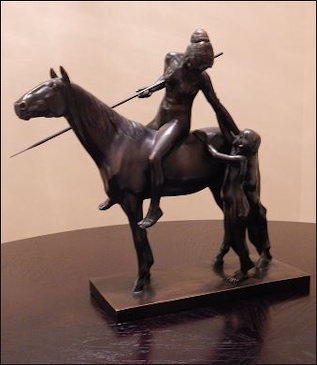
“So we could never agree with them. If you want to keep us for wives and to have the name of fair men, go to your parents and let them give you the allotted share of their possessions, and after that let us go and live by ourselves.” The young men agreed and did this. So when they had been given the allotted share of possessions that fell to them, and returned to the Amazons, the women said to them: “We are worried and frightened how we are to live in this country after depriving you of your fathers and doing a lot of harm to your land. Since you propose to have us for wives, do this with us: come, let us leave this country and live across the Tanaïs river.” To this too the youths agreed; and crossing the Tanaïs, they went a three days' journey east from the river, and a three days' journey north from lake Maeetis; and when they came to the region in which they now live, they settled there.
“Ever since then the women of the Sauromatae have followed their ancient ways; they ride out hunting, with their men or without them; they go to war, and dress the same as the men. The language of the Sauromatae is Scythian, but not spoken in its ancient purity, since the Amazons never learned it correctly. In regard to marriage, it is the custom that no maiden weds until she has killed a man of the enemy; and some of them grow old and die unmarried, because they cannot fulfill the law.”
“Soon, the Amazons and the Scythians consolidated their camps, and the young men extended a proposal: Why not come back and live with them? They had money, houses, and parents—surely settled life would be better than life on the steppe. The Amazons, incredulous, made a proposal in return: Why not leave town behind and live as they did: riding, raiding, and sleeping under the stars? The men packed their things. Herodotus reports that the Sarmatians, the people descended from that union, created a society characterized by gender equality, in which men and women led the same sort of life. It’s a story, Mayor points out, in which the “answer to the question of who will be dominated and tamed is no one.”“
Herodotus wrote in “Histories” Book 4, 110.1-117.1: “The youth went away and told his comrades; and the next day he came himself with another to the place, where he found the Amazon and another with her awaiting them. When the rest of the young men learned of this, they had intercourse with the rest of the Amazons. Presently they joined their camps and lived together, each man having for his wife the woman with whom he had had intercourse at first. Now the men could not learn the women's language, but the women mastered the speech of the men; and when they understood each other, the men said to the Amazons, “We have parents and possessions; therefore, let us no longer live as we do, but return to our people and be with them; and we will still have you, and no others, for our wives.” To this the women replied: “We could not live with your women; for we and they do not have the same customs. We shoot the bow and throw the javelin and ride, but have never learned women's work; and your women do none of the things of which we speak, but stay in their wagons and do women's work, and do not go out hunting or anywhere else.
“So we could never agree with them. If you want to keep us for wives and to have the name of fair men, go to your parents and let them give you the allotted share of their possessions, and after that let us go and live by ourselves.” The young men agreed and did this. So when they had been given the allotted share of possessions that fell to them, and returned to the Amazons, the women said to them: “We are worried and frightened how we are to live in this country after depriving you of your fathers and doing a lot of harm to your land. Since you propose to have us for wives, do this with us: come, let us leave this country and live across the Tanaïs river.” To this too the youths agreed; and crossing the Tanaïs, they went a three days' journey east from the river, and a three days' journey north from lake Maeetis; and when they came to the region in which they now live, they settled there.
“Ever since then the women of the Sauromatae have followed their ancient ways; they ride out hunting, with their men or without them; they go to war, and dress the same as the men. The language of the Sauromatae is Scythian, but not spoken in its ancient purity, since the Amazons never learned it correctly. In regard to marriage, it is the custom that no maiden weds until she has killed a man of the enemy; and some of them grow old and die unmarried, because they cannot fulfill the law.”
Shipwrecked Sailors and the Amazons
An island made famous by defiant Ukrainian border guards has a remarkable mythic story associated with it. In February 2022, a Russian warship issued a command to Ukrainian border guards stationed on Snake (Zmiinyi) Island in the Black Sea, saying to Ukranian soldiers “lay down arms and surrender to avoid bloodshed and unnecessary victims.” The soldiers responded, “Go fuck yourself.” The island was bombed; many guards died; and President Volodymyr Zelensky awarded them the Hero of Ukraine medal. Some were captured by Russian forces as a Ukrainian warship attempted to evacuate them. [Source: Candida Moss, Daily Beast, March 28, 2022]
Candida Moss wrote in the Daily Beast, Adrienne Mayor told me that the island has a long history of divine protection from invaders. In his On Heroes, the second-century A.D. Athenian author Philostratus, tells the curious story of a group of shipwrecked sailors who were captured by ancient Amazons. In the story, a fleet of ships blown off course by a winter storm was wrecked on the coast of modern Georgia. The marooned soldiers were captured by the Amazons who tied them to troughs. The intention of the Amazons was to fatten the soldiers up for sale to local cannibals. The sailors, as Mayor puts it in her book The Amazons, “were in luck.” One of the Amazon women fell in love with the youngest (and presumably least weathered) sailor and successfully pleaded with the queen to release the men. Mayor suggests that the young girl may have been Peisianassa (her name literally means “She Who Persuades the Queen.”), a woman who appears in some famous fifth-century B.C. artwork.
Now freed of their shackles, and possibly suffering from Stockholm syndrome, the men decide to stay with the Amazon women, enjoying the sexual freedom that life with the Amazons afforded them, and even learning their languages. In exchange they regaled their hosts with stories of the amazing things that they had seen on their travels. This is where things took a turn for the worse. The most striking of their stories involved the Leuke (White) island — named for its white marble bedrock and (allegedly) white snakes and better known to us as Snake or Serpent Island — a desert island in the northern Black Sea.
Achilles Goes Insane and Wipes Out the Amazons
Candida Moss wrote in the Daily Beast, To the ancient Greeks, Snake Island was sacred to Achilles. According to legend, Achilles was buried on Snake Island. The eighth- or seventh-century B.C. poem the Aethiopis relates that, after he received his fatal ankle injury at Troy, Achilles’ remains were transported to the White Island by his mother Thetis. As Mateusz Stróżyński writes for Antigone, later Latin authors Pliny the Elder and Arrian give the island the name the Island of Achilles. In antiquity the small island was said to be haunted by his ghost, which spent its time breeding a sacred herd of mares. As you do when you’re a ghost on an uninhabited island in the Black Sea. [Source: Candida Moss, Daily Beast, March 28, 2022]
When the Amazons, who are among history’s most famous horse-lovers, heard about Snake Island and its herd of mares, they decided to sail there. So, they commissioned their former captives turned lovers to build boats that could help transport the horses back from the island. While the ships were being constructed the sailors gave the dry-footed Amazons some instruction in sailing and rowing. When springtime arrived, they were ready to set sail.
After a long journey they arrived on Snake Island and began to cut down the trees in the forest that surrounded the sanctuary to Achilles. This violates rule number one of ancient sanctuaries: do not vandalize the sanctuary. This means no deforestation, no hunting of potentially sacred deer, no theft, and no sex within sanctuary precincts. Naturally, the now-angry spirit of Achilles enchanted the axes. Instead of cutting into the wood, they rebounded off the tree trunks and lopped off the heads of the would-be lumberjacks.
The Amazon women panicked and tried a last-ditch effort to round up the mares and herd them to the boats. They should have cut their losses. Achilles drove the mares wild. As Mayor puts it: “With pricked ears and bristling manes, the demonic horses trampled and bit the Amazons, tearing at their flesh and devouring the fallen bodies. The crazed herd of carnivorous mares, blood dripping from their teeth, stampeded to a high cliff and believing they saw a wide plain before them, hurled themselves into the sea.” A storm destroyed the Amazon fleet and an enormous wave washed away all trace of the Amazons, the sailors, and their ships.
All was right on the White Island again. Of course, as Mayor writes, this isn’t a strictly historical account. She writes, “Philostratus wove this fantastic horror story from threads of folklore, legend, myth, contemporary popular culture, authentic history, and pure imagination.” The story is also long on irony: the women known for their horsemanship are trampled to death by mares and having plotted to sell their sailors to be eaten they themselves get devoured by the horses.
But there are some snippets of truth amid the ancient horror story. Philostratus’ rough contemporary Arrian confirms that there was a temple dedicated to Achilles on the White Island, and that people who visited left gifts of rings, cups and precious stones. Inscriptions at the site in Greek and Latin refer to both Achilles and his beloved Patroclus. This suggests that it was here that Achilles and Patroclus finally got their happy ever after. For Arrian, however, the island’s cleanliness wasn’t down to phantasmic spring cleaning, but the birds that inhabited the place. Stróżyński relays that, according to Arrian, the birds would moisten their wings in the sea water each morning and then use their wings to sweep the floor of the temple. Most of the story, including the horses, is impossible. As Christopher Stedman Parmenter wrote for the Society of Classical Studies: there’s no fresh water on the island, and there are no trees.
Did the Amazons Really Exist

Joshua Rothman wrote in The New Yorker: “The natural question, when you’re faced with a story like this, is: How true is it? In “Amazons,” Mayor—a classicist, based at Stanford, who is by all accounts the world’s leading expert on ancient female fighters—argues that, even if it is not literally true in all its particulars, it is still broadly true. [Source: Joshua Rothman, The New Yorker, October 17, 2014 ]
“The evidence, she writes, points to the fact that there really were Amazons: in some archaeological digs in Eurasia, as many as thirty-seven per cent of the graves contain the bones and weapons of horsewomen who fought alongside men. (“Arrows, used for hunting and battle, are the most common weapons buried with women, but swords, daggers, spears, armor, shields, and sling stones are also found,” Mayor writes.)
“These were the women the Greeks encountered on their expeditions around the Black Sea; they inspired similar stories among travellers from ancient Persia, Egypt, China, and other places. In Greece, they were objects of romantic fascination. Their societies, in which both men and women were able to embody the martial virtues, provided a counterpoint to Greek society, in which only men could be valorous. Greek stories about Amazons, Mayor argues, expressed the ancient Greeks’ yearning for gender equality.
“For a long time, Mayor said, “Most people argued that the Amazons on Greek vases were purely symbolic—that they represented, for example, young women who weren’t yet married.” The interpretation has been challenged by “a wealth of archaeological discoveries that show that there were women who behaved like Amazons—who wore the same clothes, who used weapons, who rode horses, and who lived at the same time as the ancient Greeks.”
Amazon Graves?
Candida Moss wrote in the Daily Beast, Excavations in Russia have uncovered the graves of four ancient female warriors who were buried roughly 2,500 years ago. The women were unearthed with weapons and at least one was still adorned with an elaborate headdress at the time of her internment. This is the latest of a series of archeological discoveries that invoke the legends of the Amazons. Is this discovery evidence of their existence? [Source: Candida Moss, Daily Beast, January 5, 2020]
The most recent discovery, published in the Journal of the Akson Russian Science Communication Association, identifies the women as Scythian nomads. In the last decade, archaeologist and lead author Valerii Guliaev of the article said, the graves of eleven women (complete with weapons) were discovered. The most recent four were identified as members of three different generations. The discoveries were made in Devitsa, part of the Ostrogozhsky District of the Voronezh region in Russia.
Discoveries of graves of armed women have been found elsewhere in the Scythian burial mounds that are scattered across the huge Eurasian Steppe region (the large area of unforested grassland that stretches from northern China, through Siberia, to the northern Black Sea). The distinctive burial style used by the Scythians — mounds, that were often arranged in lines, with larger mounds being used for higher status individuals — makes the graves easy for both scholars and looters to identify. One of the remarkable things about the most recent discovery is that it had been untouched by grave robbers: the weapons and headdresses were found in situ in the graves of the women.
How the Amazons Became Mythical Figures
Joshua Rothman wrote in The New Yorker: Much of “The Amazons” is devoted to exploring how the real lives of Amazons were transformed into myth. In Greece, Mayor writes, much of the mythmaking was structured around a thought experiment: “What would happen if our Greek heroes encountered a band of Amazons? Sparks would fly!” “The original title of the book,” Mayor said, “was going to be ‘Amazons in Love and War,’ because there were just as many love stories as there were war stories.” The love stories, meanwhile, differ from one another in important ways. “In the stories that the Persians and the Egyptians told, they were often attracted to the women they were fighting: their impulse was, we want them on our side, we want them as companions and lovers.” In one of Mayor’s favorite stories, repeated in Egypt, Iran, and elsewhere, “a prince fights a warrior princess; they’re so equally matched that the fight goes on and on, and when they sit down to rest, they fall in love.” [Source: Joshua Rothman, The New Yorker, October 17, 2014 ]
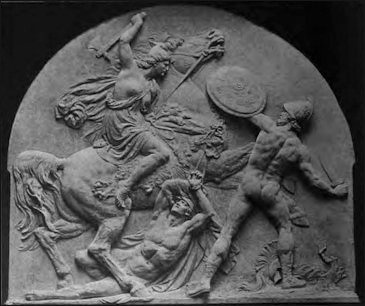
“The Greeks, by contrast, had a “uniquely dark mythic script: all Amazons must die, no matter how attractive, no matter how heroic.” The Greeks admired the Amazons—Mayor points out that, unlike other enemies of Greece, the Amazons are never represented in Greek art as fleeing from danger or begging for mercy. Lasting romance between a Greek man and an Amazon woman, though, is always portrayed as impossible. “Every Amazon that we hear about in Greek mythology is heroic—heroes who are the equals of the greatest male Greek heroes,” Mayor said. In Greek representations of Amazons, she believes, “you can discern some yearning and desire for some kind of resolution to the tension between ‘Yes, we want them as our companions,’ and ‘We couldn’t possibly, because we have to control our own women.’ “At the same time, Amazons had a special place in the lives of Greek women. “Amazons were featured everywhere, on women’s pottery, on perfume jars, on jewelry boxes, on sewing equipment. Little girls played with Amazon dolls.” It’s a glimpse, Mayor says, into “a mystery of Greek private life.”
“Thinking about Amazons continues, of course, to be a way of thinking about men, women, and how they might live together. Katherine Hepburn‘s first big break, Mayor points out, was in a play called “The Warrior’s Husband,” in which she played an Amazon named Antiope. The play was a satire of male-female role reversal; Hepburn, twenty-four and dressed in a short tunic and boots, made her entrance by “leaping down a flight of stairs with a dead stag over her shoulders.” (Later, Mayor writes, she “cut a dashing figure in her signature trousers, at once shocking and fabulous, which also fueled her Amazonian image.”) Today, Mayor is part of the “Amazons Ancient and Modern” Facebook group: “Slightly more men than women make up the membership,” she said. She regularly hears from Amazon enthusiasts—not just scholars, but also “women who ride horses and shoot bows and arrows, or who re-create Scythian bows. All these women practice mounted archery every weekend; they’re experts, they travel around the world competing with men and shooting arrows on horseback.” These mounted archers have helped Mayor interpret details in paintings of Amazons: “They notice the use of nomad-style thumb releases. . . heel guards and ankle spurs, they know what it takes to shoot a Parthian shot when you don’t have any reins or a saddle. You have to do this every day to know that.” People ask her all the time whether she herself is a “real Amazon.” “I certainly believe in gender equality and female ferocity,” she says, laughing. “But I’m not actually a horsewoman.”“
How the Amazons Lent Their Name to a Big River and Online Retailing Giant
The first European man to set eyes on the Amazon was Spanish explorer Vicente Pinzón, a captain on Christopher Columbus' ship the Niña. He discovered it while doing a survey of the South American coast in 1500. The first man to travel its entire length was Francisco de Orellana, a one-eyed conquistador immortalized in the bizarre Werner Herzog movie “Aguirre Wrath of God.” After descending from the Andes highlands in present day Ecuador, he floated down the Napo river to the Amazon, and finally to the to the Atlantic Ocean on a one-and-a-half-year, 4,000-kilometer (2,800-mile) journey. Along the way he was attacked by women warriors — which he believed were the "Amazons" from Greek mythology — hence the name of the river.
Candida Moss wrote in the Daily Beast: Certainly, the mythology of the Amazons as man-hating lesbian “barbarians” who enslaved weaker men and killed or mutilated infant boys is the stuff of legend. Much of that legend comes from more recent historiography. Sexism and colonialism loom large in the imagination of medieval and European historians and explorers. Both Christopher Columbus and Sir Walter Raleigh mention the Amazons even though their travels took them thousands of miles away from the historical origins of the horse-riding warrior women of antiquity. Both ancient and modern Europeans like to use ‘Amazon’ as a euphemism for ‘barbarian’ and ‘other.’ [Source: Candida Moss, Daily Beast, January 5, 2020]
According to Entrepreneur: When Jeff Bezos first started his virtual venture, he wanted to call the company Cadabra, as in abracadabra. He phoned his Seattle lawyer to try out the name, but the attorney misheard Bezos and replied, "Cadaver! Why would you want to call your company that?" Bezos quickly reconsidered and adopted the name Amazon.com.” [Source: Entrepreneur magazine biography of Jeff Bezos, October 10, 2008]
Shana Lebowitz wrote in Business Insider: “It was the mid-90s when Bezos and his wife, MacKenzie, started exploring other possibilities. They registered the domain names Awake.com, Browse.com, and Bookmall.com. They also registered the domain name Relentless.com and kept it (if you type that into your browser today, you'll be redirected to Amazon.com). Then Bezos started paging through the "A" section of the dictionary. At the time, website listings were alphabetized, so he wanted a word that started with A. When he landed on the word "Amazon," the name of the largest river on the planet, he decided that was the perfect name for what would become earth's largest bookstore. [Source: Shana Lebowitz, Business Insider, May. 7, 2018]
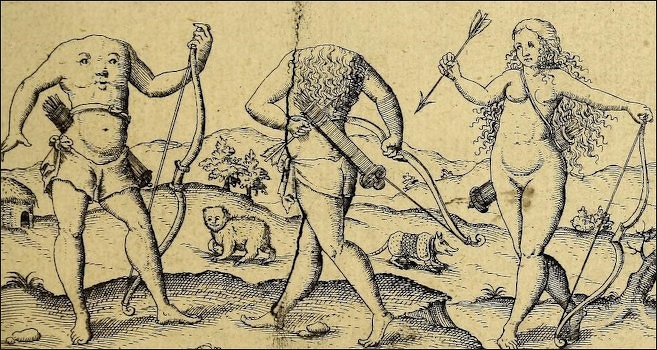
Amazons and creatures found in the New World
Brad Stone, author of the 2013 bestseller, "The Everything Store," wrote Bezos "walked into the garage" — Amazon's makeshift office at the time — "and informed his colleagues of the company's new name. He gave the impression that he didn't care to hear anyone's opinion on it." The URL for Amazon was registered on November, 1, 1994.
Image Sources: Wikimedia Commons
Text Sources: Internet Ancient History Sourcebook: Greece sourcebooks.fordham.edu ; Internet Ancient History Sourcebook: Hellenistic World sourcebooks.fordham.edu ; BBC Ancient Greeks bbc.co.uk/history/; Canadian Museum of History, Perseus Project - Tufts University; perseus.tufts.edu ; MIT Classics Online classics.mit.edu ; Gutenberg.org, Metropolitan Museum of Art, National Geographic, Smithsonian magazine, New York Times, Washington Post, Live Science, Discover magazine, Natural History magazine, Archaeology magazine, The New Yorker, Encyclopædia Britannica, "The Discoverers" and "The Creators" by Daniel Boorstin. "Greek and Roman Life" by Ian Jenkins from the British Museum, Wikipedia, Reuters, Associated Press, The Guardian, AFP and various books and other publications.
Last updated September 2024
